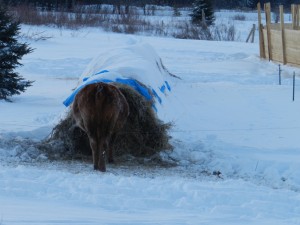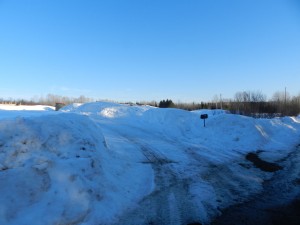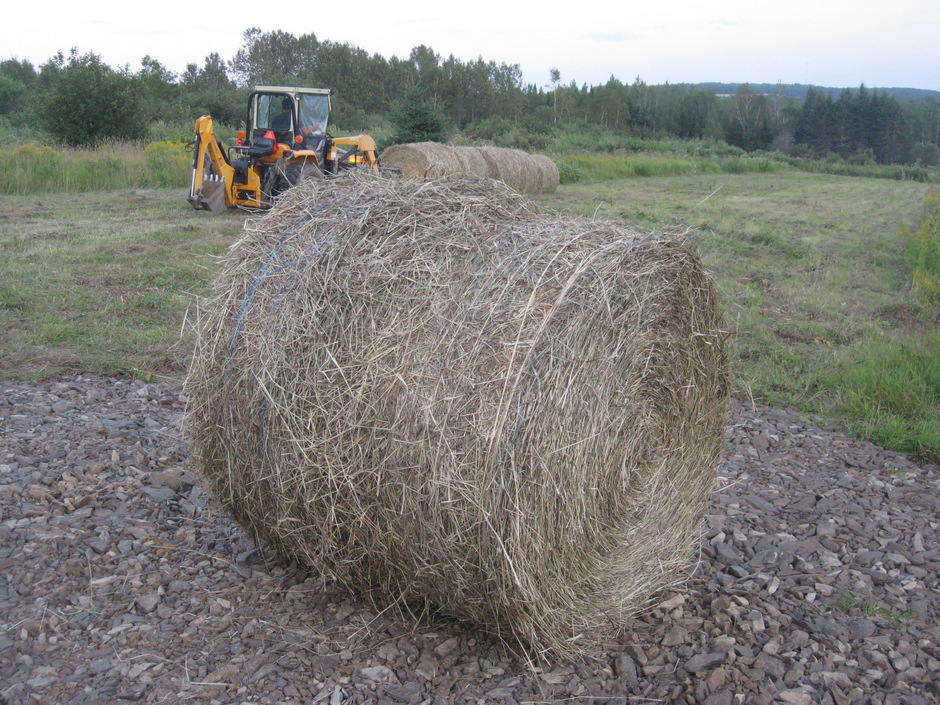 This is the first in a four part series we put together based on our first winter of bale grazing. If you haven’t tried this method of hay feeding yet, read on to learn if it may be right for you.
This is the first in a four part series we put together based on our first winter of bale grazing. If you haven’t tried this method of hay feeding yet, read on to learn if it may be right for you.
We are at the beginning of April, and we are finally starting to crawl out of winter. For the past 3 months or so our driveway has been lined with snow banks that you can get lost in, our firewood pile has an intricate system of tunnels, and we are still having a hard time remembering what grass- of any color and kind- looks like. Welcome to a winter in the north woods!
 As we anticipate the arrival of spring in this part of the country and the birth of our first crop of baby calves (with some grass, hopefully!), we want to take some time to introduce you to an innovative and cost-effective way to feed your beef cattle during the winter months: hay-bale grazing.
As we anticipate the arrival of spring in this part of the country and the birth of our first crop of baby calves (with some grass, hopefully!), we want to take some time to introduce you to an innovative and cost-effective way to feed your beef cattle during the winter months: hay-bale grazing.
A little background first:

Before we moved to Maine, we lived amidst beef cattle ranchers with 500+ head herds and $20,000.00 + tractors. For many of those ranchers, they spent countless years doing backbreaking work, cultivating their land and building their herd size in order to afford that tractor. For a small handful, though, there was a pile of debt at the local bank as tall as the snow banks in our driveway.
Please don’t get us wrong, we would LOVE to have a tractor. The sky is the limit when you have a tractor. But, we would be joining the group at the bank if we went that route straight out of the chute, so to speak. We feared we would never make it out of the snow bank. We are taking baby steps towards buying that tractor. It is what works for us and our situation at this time in our operation. Every person is different and therefore every operation runs to what works for those individuals. The guy down the road, with the tractor, is working towards the same goal as us. We are all running the same race and one day, when we hopefully have financial success in raising and breeding beef cattle, we will be able to purchase that tractor.
For the time being, we have to think outside the box – way outside the box. In order to make a real go at having a successful beef cattle operation, we had to be creative and take a bit of risk. We asked ourselves: “How can we feed a herd of cattle during the winter with no tractor?”
Many people would say you can’t. No way, end of story. Take out a loan, get the the tractor and be done with it (and spend the next however many years paying it off). The initial cost of buying (whether outright or with assistance) a tractor doesn’t end with the purchase price. For example, you will have maintenance, repair, and fuel costs. Preferably, you would like a place to work on that maintenance and repair when the temperature outside is serving up a toasty -30 degrees, with a nice side of wind chill and your cattle are crying for their food. We do not have such a place to work on a tractor in the wintertime. We hope to one day have one but again, baby steps.
To be fair, though, we did borrow a small tractor for a specific task last fall. The picture below can give you an idea of what we needed the tractor for but we will discuss that in our next post.
Do you know how large and how heavy a round hay bale is? Depending on the size, a round hay bale can weigh more than a thousand pounds. They.are.BIG.and.HEAVY.
 Our hay bales average 500 lbs.
Our hay bales average 500 lbs.
We had to shift gears and instead of bringing the hay bales to our cows, we had to think of a way to bring our cows to the hay bales instead.
We found the solution to our problem in the book “Grass-fed Cattle: How to Produce and Market Natural Beef”, by Julius Ruechel.

This book provides a wealth of information, from buying your first herd of beef cattle to marketing them for the consumer and everything in-between; the beginning beef cattle farmer (us) to the most seasoned beef cattle farmer will learn something from this book. We could dedicate an entire post to just this book (and we may at some point) but for right now, we will narrow our focus to what we learned about feeding beef cattle during the winter. Complete with diagrams, visuals and detailed methodology, we discovered though reading this book the method of winter hay-bale grazing.
What a brilliant concept and for us, the perfect solution to our problem.
We also learned from a local cattle farmer turned friend and mentor, that he’d been successfully bale grazing in northern Maine for a few years. That was the added boost we needed to realize that this could actually work…..even in more than 3 feet of snow.
Reading and hearing about how to do it was one thing, the actual application of this concept was – well, let’s just say we definitely got our feet wet in becoming bonafide owners of a beef cattle herd.
Click here for our next post in our blog series on winter hay-bale grazing!
Leave a Reply